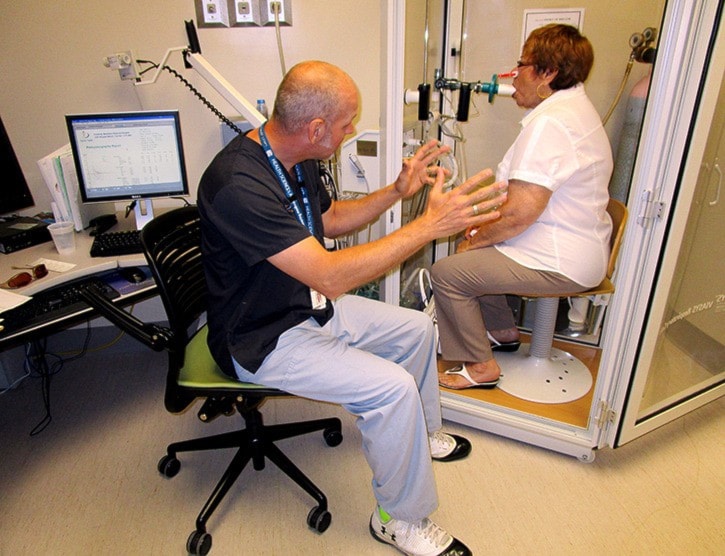Breathe in, breathe out. It's that easy, right?
Not for Trail resident Georgina Fleming. She suffers from asthma and chronic obstructive pulmonary disease, commonly called COPD, and is especially bothered during fire season.
Before she leaves her house, she sticks her head out the window and if it's hazy out she'll reschedule her appointments, unless of course there's one she can't miss like visiting a respiratory therapist at Kootenay Boundary Regional Hospital.
“Then I have to use my inhaler all the way and I just go right through the house to the garage and get in the car and I'm gone, with the windows shut,” she said Wednesday in between routine testing.
Fleming is not alone, according to Greg Rollins, Kootenay Boundary professional practice leader for respiratory services. In fact, he says fire season guarantees a surge in patients at the hospital and often can bump up the typical 100 referrals he receives a week.
“As soon as people see smoke in the sky like this and haze and if you can smell the smoke then you can pretty much know that it's high enough to affect you if you're considered at risk (a person with COPD, diabetes, the elderly, young and pregnant),” he explained.
But if you're still not sure, he recommends checking out bcairquality.ca.
The online tool maps out the province's air quality down to the nearest community with a simple click of the mouse. The province measures particulate matter 2.5 (from fire), ozone and nitrogen dioxide levels in the air to determine air quality. The numbered and coloured scale offers different referrals based on whether website users are at low, moderate or high risk.
“Particulate matter can be fine, or course and this is considered fine particulate matter and it's significant because it is the one that penetrates most easily into your lungs and into your blood stream,” he explained.
“And that has a direct relationship to mortality so we know that when this air quality health index goes up, there will be more cardiac/respiratory events, strokes, doctor visits and even emergency room visits.”
Trail's closest community in the index is Castlegar, which sat at 21 micrograms per cubic meter (ug/m3) Tuesday morning, when normally it rests in the 5-10 range.
Trail's air quality generally is at low risk (1-3 on the scale through 10).
But when fire season billows in, the scale can easily shift to moderate and so on.
The haze is a constant reminder for Rollins and his team.
Patients are often already in tune with their own health, which can be quite apparent when it comes to symptoms of wheezing and shortness of breath.
“These exposures can affect them in the short term over the longterm,” he said. “A pregnant mom can have a low birthweight baby if they are continuously exposed to higher levels of this kind of pollution; kids that live closer to really busy highways can actually develop asthma from living close to the pollution source.”
Breathing is not easy for Fleming, who has had trouble for the past 10 years and relies on a nebulizer and respiratory health visits to her home under the Breathe Well program.
The mood is lightened during her visit with comedian, I mean respiratory therapist Join Marion attending to her.
“Breathe in and out,” Marion coaches on. “Deep breath in and blast out, and relax.”
The room is filled with coughing from the simple spirometry test and she's relieved with a quick puff of Ventolin.
